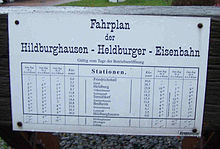Hildburghausen – Lindenau-Friedrichshall railway line
| Hildburghausen-Lindenau-Friedrichshall | |||||||||||||||||||||||||||||||||||||||||||||||||||||||||||||
|---|---|---|---|---|---|---|---|---|---|---|---|---|---|---|---|---|---|---|---|---|---|---|---|---|---|---|---|---|---|---|---|---|---|---|---|---|---|---|---|---|---|---|---|---|---|---|---|---|---|---|---|---|---|---|---|---|---|---|---|---|---|
| Course book range : | 165 b (1939) | ||||||||||||||||||||||||||||||||||||||||||||||||||||||||||||
| Route length: | 29.7 km | ||||||||||||||||||||||||||||||||||||||||||||||||||||||||||||
| Gauge : | 1000 mm ( meter gauge ) | ||||||||||||||||||||||||||||||||||||||||||||||||||||||||||||
| Maximum slope : | 25 ‰ | ||||||||||||||||||||||||||||||||||||||||||||||||||||||||||||
| Minimum radius : | 40 m | ||||||||||||||||||||||||||||||||||||||||||||||||||||||||||||
| Top speed: | 25 km / h | ||||||||||||||||||||||||||||||||||||||||||||||||||||||||||||
|
|||||||||||||||||||||||||||||||||||||||||||||||||||||||||||||
The Hildburghausen – Lindenau-Friedrichshall railway , also known as the Hildburghausen-Heldburger Eisenbahn , was a narrow-gauge railway almost 30 kilometers long that connected Hildburghausen to the Heldburger Land to the south .
history
The railway line was a "Meiningsche Staatsbahn" because the construction costs of 750,000 marks were largely financed by the Duchy of Saxony-Meiningen . The construction of the railway was carried out in accordance with a contract dated January 12, 1877 by the Localbahn-Bau und Betriebs-Gesellschaft Wilhelm Hostmann & Co. from Hanover, which also initially led the operation until finally the railway construction and operating company Vering & Waechter die Management took over.
The inauguration of the section from Hildburghausen to Heldburg was on July 1, 1888. On December 1, the remainder to Lindenau-Friedrichshall was put into operation. The entire railway passed into Prussian state ownership on July 16, 1895 , from 1920 it was part of the network of the Deutsche Reichsbahn and belonged to the Reichsbahndirektion Erfurt . On the Easter holidays of 1946, the dismantling of the railway line began as part of the reparations payments to the Soviet Union. Two station buildings were preserved, the Heldburg station and the Seidingstadt station . The same applies to the loading ramp of the Friedrichshall salt works at the end of the route. A nine-kilometer cycle path now runs on the former railway line between Hildburghausen and Stressenhausen.
route
A terminus of the narrow-gauge railway was in Hildburghausen on the southern side of the Werrabahn station at an altitude of 377 m above sea level. NN and was connected to their platforms via a steel footbridge. From there, the route followed the Römhilder Straße on the eastern side to Leimrieth , where after 3.5 kilometers the culmination point at 420 m above sea level. NN was reached. Behind Leimrieth, the route ran to the southeast in the direction of Stressenhausen in order to bypass the wooded Hahnritz ridge in a large arc. This was followed by the Bedheim train station, which was east of the town where the road to Stressenhausen crossed. Before Simmershausen, the train reached the road from Leimrieth via Bedheim to Simmershausen. From here it followed on the north side of the road to Simmershausen, in order to then reach the valley of the Kreck with Streufdorf in an eastward direction parallel to the road . There the route turned south to Heldburg and again ran mostly parallel to the road to Lindenau-Friedrichshall, the other terminus there was the Friedrichshall salt works. A link with the normal-gauge railway line Breitengüßbach – Dietersdorf , which ended in the Bavarian Dietersdorf six kilometers away, did not come about.
traffic
Usually three pairs of passenger trains ran on the route every day, only in the period from 1912 to 1914 up to five pairs of trains drove daily. They only led the 3rd grade. The travel time was between 100 and 120 minutes. Initially, locomotives of the T 31 series were used as locomotives, followed by the T 33 and T 40 series later . Around 1900 the Janney coupling was introduced on the line and used until the end of operation.
literature
- Hans Löhner: The little train from Hildburghausen to Lindenau-Friedrichshall , Verlag Michael Resch, Neustadt bei Coburg 2000, ISBN 3-9805967-5-3 .
- Klaus Kieper, Reiner Preuß : Narrow Gauge Railway Archive. transpress VEB Verlag for Transport, Berlin 1980, pp. 245–249
Web links
Individual evidence
- ↑ Hans Löhner: The Bimmelbähnle from Hildburghausen to Lindenau-Friedrichshall , page 11



